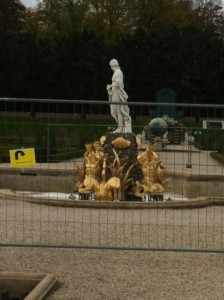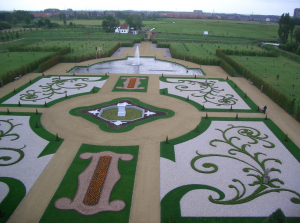Just over six years ago (oh, how time flies…) I wrote about a possible penalty for Paleis Het Loo for using too much water for their fountains, causing problems with groundwater levels in the surrounding areas. The main problem was a leak in the basin of the Venus fountain.
 Now, the museum is replacing parts of the basins in the ‘Benedentuin‘, in order to prevent further problems. And the heavily infected box in the parterres de broderie, is also replaced.
Now, the museum is replacing parts of the basins in the ‘Benedentuin‘, in order to prevent further problems. And the heavily infected box in the parterres de broderie, is also replaced.
The museum posted the photo to the left on Twitter.
Fountains
During the restoration that ended in the early 1980s, the basins of the fountains were made out of concrete. This choice was made to reduce costs. Now the basins of the Venus fountain and the Hercules fountain will be made out of stone from a Belgian quarry, in line with the description that Walter Harris gave of the garden in 1699. 1Follow the link and scroll down for a description of the work in English. Or flip the pages and start reading. Let’s hope that the replacement solves the problems with groundwater levels.
Parterres de broderie
 The problems with typical box (Buxus) deseases like Cylindrocladium buxicola and Volutella buxii started in 1997/1998 in England. Through Belgium the deseases reached The Netherlands, infecting many box plantations among which the garden of Sypesteyn (Loosdrecht) and Paleis Het Loo. In Hampton Court’s Privy Garden (like Het Loo a restored William III garden), box has been replaced three times since the first infection just before the turn of the century.
The problems with typical box (Buxus) deseases like Cylindrocladium buxicola and Volutella buxii started in 1997/1998 in England. Through Belgium the deseases reached The Netherlands, infecting many box plantations among which the garden of Sypesteyn (Loosdrecht) and Paleis Het Loo. In Hampton Court’s Privy Garden (like Het Loo a restored William III garden), box has been replaced three times since the first infection just before the turn of the century.
Replacing the box every x years is becoming expensive, reason for gardens all over Western Europe to look for resistent box, or replacement by a different plant altogether. The latter solution is chosen, in the form of Ilex crenata ‘Dark Green’ (images). 2In April 2011 an article in Groen already preluded on the upcoming replacement, listing alternatives and their results: ‘Problemen met buxus en mogelijke vervangers’, Groen (april 2011) pages 10-16. The image above is a random example of Ilex in a parterre, probably somewhere in Germany. The image above shows Ilex crenata used in the garden of kasteel Assumburg in Heemskerk. 3Kindly brought to my attention by Petra Doeve. The reconstruction of this garden has just been completed. The design is by Nico Brantjes, the parterres are based on a contemporary engraving of the garden. The gravel is surprisingly artificial, this webite shows how the hardware of the parterres was created (in Dutch, and I issue an advertisement alert!).
The work on the fountains has already begun, work on the parterres de broderie (where corten steel will replace the ‘hosthaliet’ patterns from the 1980s) will start soon. Planting shall take place next Spring. Execution of the work is in the hands of the Rijksgebouwendienst. The garden will remain open during the winter.
Footnotes
| ↑1 | Follow the link and scroll down for a description of the work in English. Or flip the pages and start reading. |
|---|---|
| ↑2 | In April 2011 an article in Groen already preluded on the upcoming replacement, listing alternatives and their results: ‘Problemen met buxus en mogelijke vervangers’, Groen (april 2011) pages 10-16. |
| ↑3 | Kindly brought to my attention by Petra Doeve. The reconstruction of this garden has just been completed. The design is by Nico Brantjes, the parterres are based on a contemporary engraving of the garden. The gravel is surprisingly artificial, this webite shows how the hardware of the parterres was created (in Dutch, and I issue an advertisement alert!). |


